 Mysteries
Mysteries  Mysteries
Mysteries  History
History 10 Surprising Stories About the Texas Rangers
 Humans
Humans 10 Philosophers Who Were Driven Mad by Their Own Theories
 Miscellaneous
Miscellaneous 10 Video-Game-Worthy Weapons and Armors from History
 Weird Stuff
Weird Stuff 10 Psychics Who Accurately Predicted Wartime Events
 The Arts
The Arts 10 Pieces of Art Inspired by a Broken Heart
 Health
Health 10 Science Fiction-Sounding New Medical Treatments
 History
History 10 Surprising Facts About the Father of Submarine Warfare
 Space
Space Ten Astonishing New Insights into Alien Worlds
 Weird Stuff
Weird Stuff 10 Bizarre Summer Solstice Rituals Still Practiced Today
 Mysteries
Mysteries Top 10 Haunting Facts About the Ghost Ship MV Alta
 History
History 10 Surprising Stories About the Texas Rangers
 Humans
Humans 10 Philosophers Who Were Driven Mad by Their Own Theories
Who's Behind Listverse?

Jamie Frater
Head Editor
Jamie founded Listverse due to an insatiable desire to share fascinating, obscure, and bizarre facts. He has been a guest speaker on numerous national radio and television stations and is a five time published author.
More About Us Miscellaneous
Miscellaneous 10 Video-Game-Worthy Weapons and Armors from History
 Weird Stuff
Weird Stuff 10 Psychics Who Accurately Predicted Wartime Events
 The Arts
The Arts 10 Pieces of Art Inspired by a Broken Heart
 Health
Health 10 Science Fiction-Sounding New Medical Treatments
 History
History 10 Surprising Facts About the Father of Submarine Warfare
 Space
Space Ten Astonishing New Insights into Alien Worlds
 Weird Stuff
Weird Stuff 10 Bizarre Summer Solstice Rituals Still Practiced Today
Top 10 Long-Term Space Exploration Problems We Have Yet To Solve
Everyone is excited about the possibility of a manned mission to Mars. There is even speculation that the first humans will land on Mars in the 2030s. Well! That could be true. But it is actually harder than it looks. A manned mission to Mars could remain a pipe dream considering current technology and political trends, especially in the United States.
There are also several problems over which we have no control. This often involves our bodies and the conditions on Mars itself. It seems like Mars is out to kill the first humans who set foot on it—an opinion shared by several people including Elon Musk, who may revolutionize space travel. Nevertheless, we will keep our fingers crossed.
10 Money
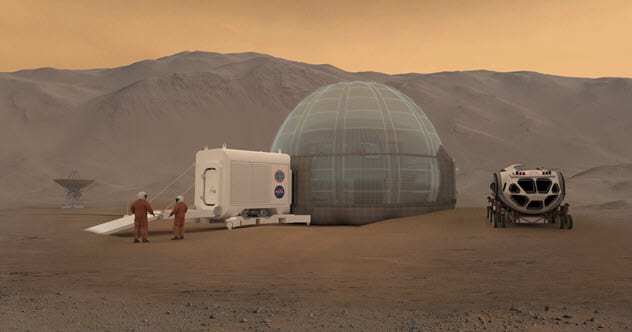
NASA cannot afford a manned mission to Mars. This was revealed in July 2017 when William Gerstenmaier, NASA’s chief of human spaceflight, revealed that the agency does not receive enough funding from the US government to make NASA’s first Mars landing scheduled for the 2030s realistic.
NASA, private space agencies, and nonprofits give vastly different figures when estimating the cost of a manned mission to Mars. This ranges from $1 trillion spread over 25 years (as proposed by the nonprofit Mars Institute) to $100 billion spread over 30–40 years (as proposed by NASA). However, NASA cannot afford their estimate.
NASA received $19.5 billion in funding for the 2017 fiscal year. That amount seems like a lot until we realize that the agency splits this money between several space missions, programs, and research. Considering current trends, NASA’s funding drought is unlikely to end anytime soon. Its budget has only grown by a measly 2 percent a year within the past few years.[1]
9 Loneliness

Humans are social creatures and often require interaction. Researchers fear this could become a problem during an expedition to Mars. A few years ago, researchers had a group of people live in an isolated habitat in the Arizona desert for a considerable period of time.
They noted that some participants soon suffered from depression and mood swings. Some also became hostile and mostly did not talk to each other for 18 months. Their few interactions were limited to brief conversations about running the facility. Although the team later had psychologists to help them, astronauts on Mars will not have the same privilege.
The results of this test have made some researchers question future plans to send just two astronauts to Mars in a single spacecraft. The astronauts will probably become bored, depressed, and could even start to dislike each other, which could lead to their doom. However, some researchers think this is unlikely to happen if the two astronauts have compatible personalities.[2]
8 The Dust Storm
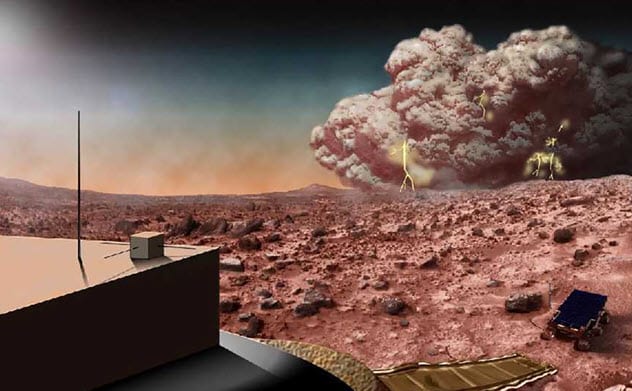
In January 2004, the NASA space rover Opportunity landed on Mars for a 90-day mission (in Mars days) to find evidence of water on the Red Planet. Opportunity completed its assignment almost immediately and went on to complete more missions over 15 years. Its surprising survival streak ended in June 2018 when it lost contact with NASA during a dust storm.
Opportunity often hibernated at night because it ran on solar power. However, it probably switched to its backup battery after the dust from the storm covered its solar panels. Opportunity ran on its batteries until it died. NASA fears a repeat incident could happen with the solar-powered stations used by astronauts on Mars.
Mars experiences two types of dust storms. The first and commonest are the regular storms that could cover large swathes of land as wide as a whole continent on Earth. Thankfully, these storms are light and only last for a few weeks. The other type—like the one that killed Opportunity—is the rarer but stronger “global dust storm” that covers the entire planet.
Global dust storms occur every 5.5 Earth years (three Mars years) and could last for months. Besides covering the solar panels, they could also block sunlight from reaching Mars, which could put the stations and astronauts in jeopardy. Thankfully, Mars dust storms are unlikely to cause serious physical damage to the stations. They are more of a breeze than a storm despite the name.[3]
7 Food
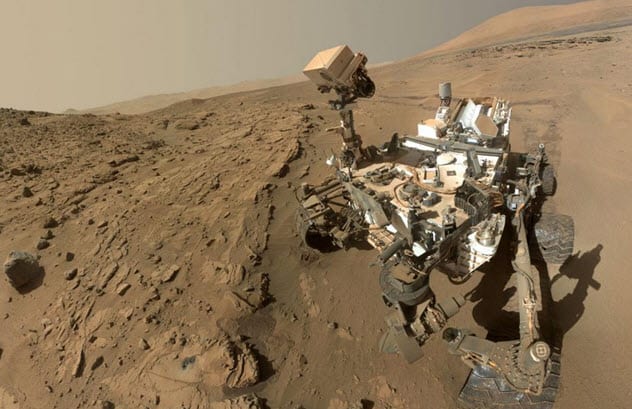
A study by PhD students at the Massachusetts Institute of Technology (MIT) revealed that a human colony on Mars could die of starvation. The group based their study on the manned mission planned by Mars One.
The organization wants to set up a human colony of 25–40 individuals on Mars by 2025. Food will be provided by crops grown inside the habitat of the colonists. An MIT study to simulate that habitat has revealed that the astronauts will need to choose between getting enough food or oxygen.
The food and oxygen levels in the habitat are linked because plants produce oxygen as a by-product. On Mars, that oxygen will be used to sustain the lives of the astronauts. The MIT study revealed that the plants will produce excessive oxygen if they produce enough food to feed everyone in the habitat.
This will clearly be detrimental to the lives of the astronauts because breathing excessive amounts of oxygen could kill them. However, the oxygen levels would be balanced if the plants produce lesser amounts of food, which would not be enough to feed everyone. The researchers say that this problem could be solved by developing an “oxygen removal system,” which does not exist for now.[4]
6 Spacecraft

The race to land the first human on Mars is currently led by NASA, SpaceX, and Blue Origin. In fact, all three organizations already have spacecraft that could take us to Mars. However, their rockets use dangerous fuels and would take too long to get to Mars from a human safety perspective.
NASA is trying to solve this by developing the Space Launch System that uses liquid hydrogen and some other chemicals for fuel. SpaceX is considering altering its spacecraft to use liquid methane for fuel, while Blue Origin is settling for liquid hydrogen. However, some still doubt whether these new spaceships and fuels will get us to Mars.[5]
One is Chris Hadfield, a former NASA astronaut, who likened traveling to Mars—in even the latest spaceships in development—to crossing an ocean in a canoe. Hadfield believes that the dangers of space and the unpredictability of the spaceships will kill most astronauts long before they land on Mars.
Curiously, this opinion is shared by SpaceX CEO, Elon Musk, who once mentioned that the first manned Mars mission will probably lead to death.
5 Surgery

As the possibility of long-term manned space missions to the Moon and even Mars becomes a reality, scientists have started to grapple with the problems posed by performing surgery in space. The unique environment of space means sick astronauts are likelier to die of minor wounds and infections there than on Earth.
Astronauts sent to the International Space Station (ISS) are often trained to perform certain medical procedures like administering injections, stitching wounds, and even extracting a tooth. However, they would need to quickly return to Earth on a spacecraft permanently docked at the ISS if they have more severe medical issues.
This is because the sick bay on the ISS is no better than a first aid kit. Even if the sick bay rose to the same standard as a hospital and had a permanent doctor (which it does not), the lack of gravity would be a real challenge.
Among other problems, blood from the wound or surgical incision could float and obstruct the view of the doctor. Worse, it could contaminate the entire cabin. Also, anesthesia does not work as well as on Earth, which means lots of pain for the astronaut.
These problems could be worse on long-term space explorations to the Moon and Mars. One suggestion is to use robot surgeons controlled in real time by human doctors on Earth. While this could work on the Moon, it would be impossible on Mars where information takes 20 minutes to reach Earth and vice versa.[6]
4 Mars Toxic Dust

Mars is filled with toxic dust that could hamper a manned mission to the Red Planet. Mars dust exists as round, fine, electrically charged silicate particles that will stick to astronauts’ suits. The dust will be difficult to remove, raising concerns that it could get into the astronauts’ base and clog crucial instruments and systems including water purifiers and air filters.
This could be deadly because the fine silicate particles could seep into the lungs where it will react with water to form harmful chemicals. The effect of the dust becomes worse when we realize that it contains gypsum and perchlorates. Gypsum is not dangerous on its own, but long-term exposure could cause eye, skin, and lung problems. Perchlorates could cause thyroid gland problems.[7]
3 Exposure To Space Elements

Space is filled with dangerous cosmic rays and irregular solar storms that could cause intense radiation. Scientists predict that astronauts traveling to Mars will be exposed to radiation levels up to 20 percent more than they will ever receive during their lifetimes on Earth. This intense radiation could cause heart, lung, and eye problems as well as neurological disorders and even cancer.
This could be a huge problem because a one-way trip to Mars could last six months. Solar storms are also unpredictable, which makes the situation worse. One solution is to develop a spacecraft that could get astronauts to Mars much faster. However, astronauts are not free from these radiation risks even when they get to Mars.[8]
Although Earth’s atmosphere shields us from dangerous radiation, Mars’s atmosphere does not provide the same protection. Scientists propose to solve this by covering the human habitat on Mars with a thick anti–solar storm material just like the shielding on parts of the ISS. Others propose that humans will be protected from the radiation if they live in the any of Mars’s numerous lava tube caves instead.
2 Our Bodies Cannot Cope
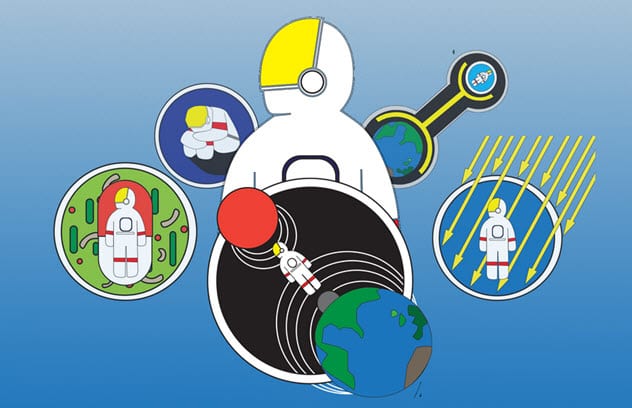
Human bodies have a hard time adjusting to the zero gravity levels experienced in the nearby ISS. This would become even worse during and after a trip to faraway Mars. Astronauts would have to cope with three different gravitational fields during a voyage to Mars.
Astronauts will experience the first gravitational field here on Earth (before and after the trip). It is the regular one we are used to. The second is the zero gravity that astronauts experience while traveling the distance between Earth and Mars. The third is the gravitational field on Mars, which is one-third the gravity on Earth.
Moving between gravitational fields causes a distortion in our senses of balance and movement. It also affects the coordination between our eyes, head, and hands. The lower gravity levels outside Earth will cause astronauts to lose valuable bone density. This makes their bones susceptible to breakage when they return to Earth.
The lower gravity level outside Earth will also cause body fluids to escape into the head. This could cause a myriad of problems including kidney stones, dehydration, loss of calcium, and eye problems. Drugs would have reduced the effects except that they work differently in space.[9]
1 The Return Trip
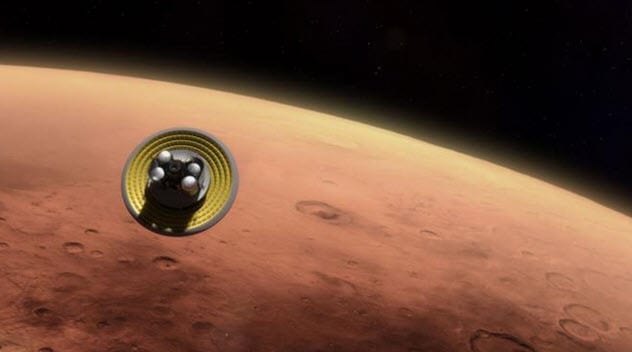
Using current technology, an expedition to Mars will be a one-way trip because astronauts who travel to Mars will be unable to return to Earth. While NASA is already developing the Mars Ascent Vehicle (MAV) to make a return trip possible, the technology is not without its own problems.
When completed, the MAV will weigh 18 tons and will carry an extra 33 tons of fuel to take off from Mars. This massive weight means that it will be unable to land safely on Mars due to the planet’s thin atmosphere, which could make the MAV burn up in the atmosphere or slam straight into the ground. For comparison, the heaviest thing we have landed on Mars is the Curiosity rover, which weighs just one ton.
NASA intends to solve this by reducing the weight of the MAV and developing an inflatable heat shield that will slow the craft’s speed during its descent to Mars. The MAV will have a minimalist interior and might not even have seats. However, the astronauts will not be standing all the way back to Earth. Instead, they will be transported to the Earth Return Vehicle (ERV), which will orbit Mars and return them to Earth.[10]
The ERV was also created to reduce weight. Instead of making a single spacecraft that will take off from Mars and bring the astronauts back to Earth, NASA will create a two-part system consisting of the MAV and the ERV. The MAV will take off from Mars’s surface and transport the astronauts to the ERV, which will bring them back to Earth.
Scientists will also reduce the weight of the MAV by having it create its fuel from Mars’s atmosphere. The MAV will extract methane (carbon and hydrogen) and oxygen, which it needs to make its fuel, from the underground water and the abundant carbon dioxide (CO2) in Mars’s atmosphere.
Read about more space problems to be overcome on 10 Obstacles Astronauts Must Overcome On A Voyage To Mars and 10 Ways Your Mars Trip Will Be More Uncomfortable Than You Think.








